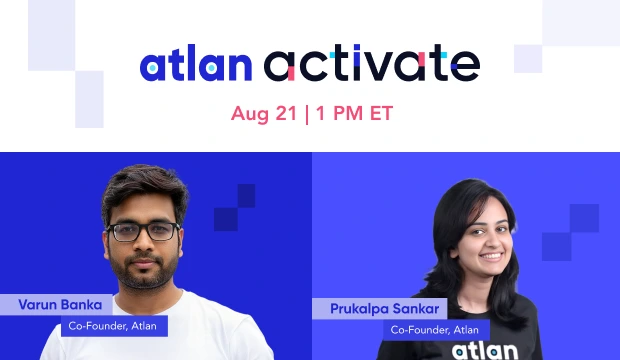How to Integrate Change Data Capture With Talend?

Share this article
Combining Talend and a change data capture tool is beneficial as it enables organizations to ensure data consistency, react swiftly to data changes, and support analytics and operations with up-to-date information, ultimately improving decision-making and operational efficiency.
Change data capture (CDC) is a technique used to efficiently track changes in a data source, such as a database. When used with Talend, a popular data integration and transformation tool, CDC can allow Talend to capture and integrate changes in real time.
This means that data in your target systems can be updated almost as soon as it changes in the source systems. This is crucial for businesses that rely on timely data for decision-making.
Now, let’s uncover the advantages of using a change data capture tool with Talend.
Modern data problems require modern solutions - Try Atlan, the data catalog of choice for forward-looking data teams! 👉 Book your demo today
Table of contents #
- Why should you use a change data capture tool with Talend?
- Talend overview
- What is change data capture?
- Steps to implement a change data capture tool with Talend
- Guidelines for effective implementation
- Change data capture for Talend: Related reads
Why should you use a change data capture tool with Talend? #
Implementing a change data capture tool is crucial because it:
- Enables real-time data synchronization.
- Improves data accuracy and integrity.
- Supports timely decision-making.
- Enhances operational and analytical processes.
Talend overview #
Talend is a prominent data integration and integrity platform provider that empowers organizations to harness data for valuable insights and business growth.
Additionally, it offers robust data quality and governance capabilities, ensuring data accuracy and compliance across diverse data environments.
What is change data capture? #
Change data capture is a technology that captures and tracks changes made to data in real-time or near-real-time.
It identifies and records modifications, additions, or deletions to data sources, enabling organizations to keep their data synchronized and up-to-date for analytical and operational purposes.
Change data capture is essential for maintaining data integrity and facilitating timely decision-making.
Steps to implement a change data capture tool with Talend #
Implementing a change data capture tool with Talend involves the following strategies:
1. Define requirements #
- Identify specific change data capture needs, data sources, and targets.
- Determine data volume, frequency of changes, and desired latency.
2. Evaluate features #
- Compare various tools and look for features like data filtering, transformation capabilities, and support for different data sources and targets.
- Assess ease of setup, scalability, and performance.
3. Consider integration #
- Ensure compatibility with existing data infrastructure.
- Evaluate integration with databases, cloud platforms, and other tools.
4. Security and compliance #
- Check data security measures, encryption, and compliance features.
- Verify support for regulatory requirements in your industry.
5. Monitoring and alerts #
- Assess built-in monitoring and alerting capabilities.
- Ensure real-time visibility into change data capture processes.
6. Cost analysis #
- Compare licensing, maintenance, and infrastructure costs.
- Consider long-term scalability and budget implications.
7. Trial and testing #
- Conduct proof-of-concept trials with selected tools.
- Involve relevant stakeholders for feedback.
8. Collaboration and support #
- Assess the available community and support resources.
- Consider user experiences and common challenges reported.
9. Avoid common mistakes #
- Ensure adequate planning and alignment with business objectives.
- Avoid selecting the wrong change data capture tool by thoroughly assessing needs.
10. Risk assessment #
- Highlight potential risks of not implementing change data capture.
- Emphasize how change data capture mitigates data inconsistencies and delays.
By following this structured approach, you can effectively evaluate the implementation of a change data capture tool with Talend and make a clear business case for its adoption in your organization.
Engaging with key stakeholders and decision-makers is also crucial to gain their support for this implementation.
Guidelines for effective implementation #
Common mistakes when implementing a change data capture tool with Talend include the following:
1. Inadequate planning: #
- Failing to define clear change data capture objectives and requirements.
- Neglecting to align change data capture implementation with business goals.
2. Wrong tool selection: #
- Choosing a change data capture tool that doesn’t meet specific data source and volume needs.
3. Monitoring neglect: #
- Not setting up proper performance monitoring and alerting systems.
- Ignoring real-time visibility into change data capture processes.
4. Data volume underestimation: #
- Underestimating the volume of data changes, leading to performance issues.
5. Latency issues: #
- Not considering latency requirements for real-time or near-real-time change data capture.
6. Data governance neglect: #
- Not addressing data governance and data security in change data capture processes.
7. Lack of alignment: #
- Failing to align change data capture initiatives with overall business objectives.
To avoid these pitfalls, organizations should follow best practices for change data capture implementation, as mentioned earlier, and conduct thorough planning, tool selection, and ongoing monitoring.
Careful consideration of data sources, a clear understanding of requirements, and regular testing are essential for successful change data capture tool implementation.
Talend change data capture as a change data capture tool #
Talend’s Change Data Capture (CDC) offers a high-performance solution for real-time data replication from a source application to any destination swiftly and efficiently.
It operates without interrupting the source system and simplifies the process, eliminating the need for complex technical skills required for full dataset extraction and replication.
Talend CDC focuses on replicating only the changed data, guaranteeing that data teams have access to the most up-to-date and reliable information for their work.
Change data capture for Talend: Related reads #
- How to Implement Change Data Capture with Azure Synapse Analytics?
- How to Integrate Change Data Capture with Redshift?
- How to Implement Change Data Capture With Amazon RDS?
Share this article











